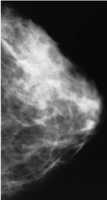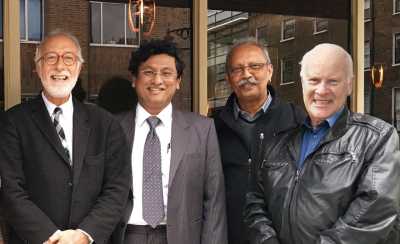
03 Jun Targeted Intraoperative Radiotherapy Avoids Side Effects of Whole Breast Radiotherapy

Prof Jeffrey S Tobias, Prof Jayant S Vaidya, Prof Max Bulsara and Prof Michael BaumMedicalResearch.com Interview with:
Professor Jayant S Vaidya
MBBS MS DNB FRCS PhD
Professor of Surgery and Oncology
University College London
MedicalResearch.com: What is the background for this study? What type of single dose radiation is used?
Response: The new paper published in the British Journal of Cancer (go.nature.com/3yN0mzu) expands on the previously published results of the large international randomised trial (TARGIT-A trial)(BMJ 2020;370:m2836), that confirmed the long-term effectiveness of Targeted Intraoperative Radiotherapy (TARGIT-IORT): a breast cancer treatment which is increasingly available throughout the world.
The TARGIT-A trial found that a single dose of targeted radiotherapy during surgery (TARGIT-IORT) is just as effective as conventional radiotherapy, which requires several visits to hospital after surgery. From the perspective of patients, it is so much better for them and also allows prompt completion of cancer treatment during the COVID pandemic.
Conventional external beam radiotherapy (EBRT) is delivered from outside the body via a radiotherapy machine (linear accelerator), and consists of a daily treatment session (known as fractions) to the whole breast, over a period between three to six weeks. Each of these treatments is given over a few minutes, but requires up to 30 hospital visits, which could be a significant distance from where the patient lives.
TARGIT-IORT is delivered immediately after lumpectomy (tumour removal), via a small ball-shaped device placed inside the breast, directly where the cancer had been. The single-dose treatment lasts for around 20 to 30 minutes and replaces the need for extra hospital visits, benefiting both patient safety and well-being. The device used is called INTRABEAM.
The new results are described on the Nature.com and UCL webpages
https://go.nature.com/3ymrplc blog
https://www.ucl.ac.uk/news/2021/may/pioneering-single-dose-radiotherapy-breast-cancer-treatment
and explained in a short video https://youtu.be/w0OMjVfJ5pY
MedicalResearch.com: What are the main findings? How long was the follow-up period?
Response: This large clinical trial, designed and run from UCL, London, UK, involved 32 hospitals and medical centres in ten countries: the UK, France, Germany, Italy, Norway, Poland, Switzerland, United States, Canada and Australia. The trial started in March 2000, and recruited 2298 patients. 1,140 patients were randomised to TARGIT-IORT and 1,158 to whole breast radiotherapy (EBRT).
The findings show that with TARGIT-IORT therapy, eight out of every ten patients had no need for any further post-operative radiotherapy treatments. There was also no increase in the likelihood of the breast cancer returning (no difference in local or distant control, no difference in breast preservation), and on difference in deaths from breast cancer.
With long term follow-up (median 8.6 years, maximum 18.90 years) local recurrence-free survival, i.e., local control of cancer, was no different between TARGIT-IORT and EBRT, in every tumour subgroup (such as tumour size, grade, lymph node involvement, ER, PgR, HER2 status)
The subgroup analysis, also revealed that with TARGIT-IORT, the overall survival was improved by 39% in the 1797 patients with grade 1 or 2 cancers, which form the majority of breast cancer patients.
Those with grade 3 cancers benefited as well, because they also avoided the need to undergo the long course of whole breast radiotherapy in 8 out of 10 cases, and had absolutely no detriment to their survival. They had the same chance of living without the cancer returning as after the long course of whole breast radiotherapy. The chance of needing additional whole breast radiotherapy (about 2 out of every 10 cases) did not change significantly with the grade of the cancer. The researchers have said that as usual the subgroup analysis its normal caveats.
The researchers provide a new online interactive decision aid for helping clinicians decide about additional EBRT after TARGIT-IORT: https://targit.org.uk/addrt.
A very important finding from the patient’s perspective was that unlike in the EBRT arm, local recurrence in the TARGIT-IORT arm was not a predictor of a higher risk of distant relapse or death. So, after receiving TARGIT-IORT, the excellent prognosis of patients is not deterred by a local recurrence, quite unlike the poor prognosis if after whole breast radiotherapy.
Finally, the researchers found that non-breast cancer mortality (from cardiovascular causes, lung problems and other cancers) was significantly lower in the TARGIT-IORT arm. This reduction in mortality was probably because of avoidance of scattered irradiation from EBRT and was seen when comparing those receiving EBRT vs those in the TARGIT-IORT arm who did not receive any additional radiotherapy. But it was also seen in the smaller group of 241 patients who received additional EBRT after TARGIT-IORT (a 62% reduction) P = 0.0091). This biologically interesting finding suggests a possible beneficial effect of delivery of TARGIT-IORT during the surgical trauma of lumpectomy in the wound micro-environment. Such abscopal (distant from the site of radiotherapy) is being increasingly recognised, and may work via immunological actions.
Previous studies have shown that TARGIT-IORT has fewer radiation-related side effects compared with conventional whole breast radiotherapy, with less pain, better cosmetic outcome and a better quality of life.
MedicalResearch.com: What should readers take away from your report?
Response: The lead author Professor Vaidya said: “These new results make it clear that the TARGIT-IORT is effective in all tumour subgroups of invasive duct cancer, the most common type of breast cancer. Our new online tool can help clinicians make a decision about additional radiotherapy (recommended in a small proportion of cases) for each individual patient.
“The finding that fewer deaths are from the avoidance of scattered radiation and the possible abscopal effect of TARGIT-IORT is important and should fuel further research, opening doors to new treatments.”
“With publication of these very positive and detailed and expanded long-term results, TARGIT-IORT should be accessible to healthcare providers and discussed with patients when surgery for breast cancer is being planned.”
Professor Michael Baum (UCL Surgery & Interventional Science) said: These results are the highest level of evidence proving not only the effectiveness of TARGIT-IORT but confirming that it avoids deaths from other causes.
“The new data is biologically very interesting and the new tools will make its application in routine clinical practice much easier. I am pleased that it will benefit thousands of breast cancer patients around the world.”
Professor Jeffrey S Tobias (Professor of Clinical Oncology, UCL and UCLH) said: With “TARGIT-IORT, the majority of patients presenting with early localised breast cancer will never need any further radiotherapy.
“They will avoid all the side effects of whole breast radiotherapy. The chance of remaining free of local recurrence (in the breast itself) is the same as with traditional treatment, but our new analysis shows that even if they do get a local relapse, it will not detract from an excellent prognosis – as good as not having a relapse – a rather different state of affairs from the more serious outlook if this were to happen after EBRT.”
Find out more at https://targit.org.uk
MedicalResearch.com: What recommendations do you have for future research as a result of this work?
Response: With the long-term results of the TARGIT-A trial now published, we continue to recruit in the TARGIT-B randomised superiority trial which is testing whether giving TARGIT-IORT tumour bed boost (rather than a postoperative external beam boost) can further improve outcomes. Nearly 1400 patients from 38 centres in 12 countries have already participated in this trial amongst mainly younger patients.
MedicalResearch.com: Is there anything else you would like to add?
Response: The TARGIT-IORT technique was developed by clinical academics, Professors Vaidya, Tobias and Baum, in 1998 in collaboration with the manufacturers.
During the past 20 years this method has been used worldwide in over 260 medical health centres in 38 countries, helping to treat more than 45,000 patients. Clinical researchers from all over the world have contributed to this research – see https://targit.org.uk/publications to see the worldwide publications
Funding for the trial was provided by the National Institute for Health Research (NIHR) Health Technology Assessment programme, UCL Comprehensive Biomedical Research Centre, and Cancer Research UK.
Disclosures are within the paper.
Citation:
Vaidya, J.S., Bulsara, M., Baum, M. et al. New clinical and biological insights from the international TARGIT-A randomised trial of targeted intraoperative radiotherapy during lumpectomy for breast cancer. Br J Cancer (2021). https://doi.org/10.1038/s41416-021-01440-8
JOIN OUR EMAIL LIST
[mailpoet_form id="5"]We respect your privacy and will never share your details.
[last-modified]
The information on MedicalResearch.com is provided for educational purposes only, and is in no way intended to diagnose, cure, or treat any medical or other condition. Always seek the advice of your physician or other qualified health and ask your doctor any questions you may have regarding a medical condition. In addition to all other limitations and disclaimers in this agreement, service provider and its third party providers disclaim any liability or loss in connection with the content provided on this website.
Last Updated on June 3, 2021 by Marie Benz MD FAAD
